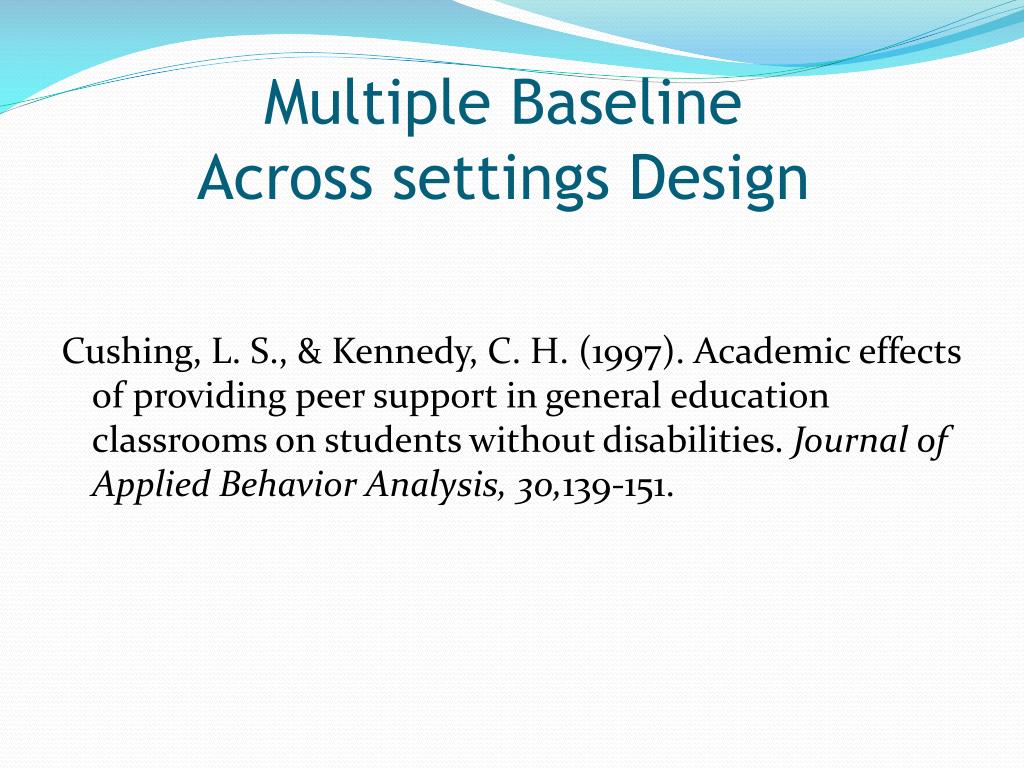Multiple baseline design Wikipedia
Table Of Content

The level of responding before any treatment is introduced and therefore acts as a kind of control condition. Both local and global baselines can be taken on a timed basis (daily or weekly), and this approach allows comparisons over time or to see a previous state. These baselines can then be archived when no longer needed, such as when a milestone has been reached and baselined. If you want to subdivide a project area into multiple components that are linked (in one or more project areas), you need a global configuration. Use the single stream pattern for basic change management that’s only in a single domain application (that is, requirements or tests or designs). Typically you use this pattern with the Requirements Management (RM) or Design Management (DM) applications, because many quality teams do not have the same motivation for tightly-controlled change.
Article Metrics
No, you will not receive any free medical treatment or health advice from participating in this study. Any lab results or information that you receive should not be used by you to make medical decisions. You should consult your doctor if you have any questions about personal medical decisions during the course of the study. To make a complete map of human health, we need data that is representative of the population. Therefore, we are selecting a sample of people with diverse ages, ethnicities, geographic locations, health histories, and other demographic and medical information using an algorithm.
Multi-Family House Plans
This basic reversal design can also be extended with the reintroduction of the treatment (ABAB), another return to baseline (ABABA), and so on. The multiple baseline design is useful for interventions that are irreversible due to learning effects, and when treatment can’t be withdrawn. In this design, behavior is measured across either multiple individuals, behaviors, or settings. Similar to the reversal design, the multiple baseline starts with the baseline (phase A), then proceeds with the intervention (phase B). Instead, the treatment is applied to another person (as in the graph above), another behavior, or another setting, depending on the variable being manipulated.
CLM configuration management: Single stream strategy
In general, if a change in the dependent variable begins shortly after a change in conditions, this suggests that the treatment was responsible. The percentage of time he spent studying (the dependent variable) was low during the first baseline phase, increased during the first treatment phase until it leveled off, decreased during the second baseline phase, and again increased during the second treatment phase. Coincidental events (i.e., history) are specific events that occur at a particular time (or across a particular period) and could cause changes in behavior. Coincidental events include divorce, changing of living situation, changes in school or work schedule, physical injury, changes in a setting such as construction, changes in coworkers or staffing, and many others. Coincidental events share the characteristic that their behavioral impact is expected to be a function of particular dates. Controlling for coincidental events requires attention to the specific dates on which events occur.
Fracture mechanisms and failure processes at stiffener run-outs in polymer matrix composite stiffened elements - ScienceDirect.com
Fracture mechanisms and failure processes at stiffener run-outs in polymer matrix composite stiffened elements.
Posted: Wed, 20 Dec 2017 09:49:44 GMT [source]
Specifically, the researcher waits until the participant’s behaviour in one condition becomes fairly consistent from observation to observation before changing conditions. The idea is that when the dependent variable has reached a steady state, then any change across conditions will be relatively easy to detect. Recall that we encountered this same principle when discussing experimental research more generally. The effect of an independent variable is easier to detect when the “noise” in the data is minimized. 1Other threats to internal validity such as (1) ambiguous temporal precedence, (2) selection, (3) regression, (4) attrition, and (5) instrumentation are addressed primarily through other design features. For example, instrumentation is addressed primarily through observer training, calibration, and IOA.
Why Are People Choosing Multi-Family House Plans?

This graph shows that the timing of treatment is not important but also shows that change is directly related to the treatment. Had we only tested subject A, we might have assumed that the treatment effected the change. Subjects B and C however, demonstrate that the treatment actually had no effect on the behavioral change. In fact, the behavior changed at the same time for each subject regardless of when the treatment was applied. Without the time-lagged approach of multiple baseline design, this phenomenon would have been missed. As with local baselines, take global baselines at key project milestones, when you need to capture the state of the product.
Testing and Session Experience
A given period of maturation may affect various participants, various behaviors, or behaviors in various settings in different ways. For example, for a child who is on the cusp of walking, a month of exposure to maturational variables may result in a significant improvement in walking, but much less change in fine motor skills. (Similar arguments can be made for comparisons across settings, persons, and other variables that might define tiers.) The point is that although the across-tier comparison may reveal a maturation effect, there are also circumstances in which it may fail to do so.
You link from work items, such as change requests in RTC, to artifacts in your domain application stream, such as change sets in RM or DM. However, because work items in RTC are not versioned, you still use only a single stream in your other domain application. There are two potential problems with the reversal design—both of which have to do with the removal of the treatment. For example, if a treatment seemed to reduce the incidence of self-injury in a developmentally disabled child, it would be unethical to remove that treatment just to show that the incidence of self-injury increases. The second problem is that the dependent variable may not return to baseline when the treatment is removed. For example, when positive attention for studying is removed, a student might continue to study at an increased rate.
Nonconcurrent designs
Based on the logic laid out in this article, we believe that the treats of maturation and testing and session experience are controlled equivalently in concurrent and nonconcurrent design. Further, for both types of multiple baselines, the threat of coincidental events should be evaluated primarily based on replicated within-tier comparisons. Any one tier may, at best, demonstrate a potential treatment effect; however, a set of three or more tiers may strongly address the threat of coincidental events and clearly demonstrate experimental control. The across-tier comparison is valuable primarily when it suggests the presence of a threat by showing a change in an untreated tier at approximately the same time (i.e., days, sessions, or dates) as a potential treatment effect.
And although there appears to be an increasing trend in the treatment condition, it looks as though it might be a continuation of a trend that had already begun during baseline. This pattern of results strongly suggests that the treatment was not responsible for any changes in the dependent variable—at least not to the extent that single-subject researchers typically hope to see. One solution to these problems is to use a multiple-baseline design, which is represented in Figure 10.4. In one version of the design, a baseline is established for each of several participants, and the treatment is then introduced for each one.
This is a significant problem for the across-tier comparison because its logic is dependent on these two assumptions. This understanding of the primary role of replicated within-tier comparisons also implies that, when there is a trade-off, design options that improve control through the within-tier comparisons should take precedence over those that would improve control through across-tier comparisons. In particular, within-tier comparisons may be strengthened by isolating tiers from one another in ways that reduce the chance that any single coincidental event could coincide with a phase change in more than one tier (e.g., temporal separation). On the other hand, across-tier comparisons may be strengthened by arranging tiers to be as similar as possible so that they would be more likely to be exposed to the same coincidental events.
Comments
Post a Comment